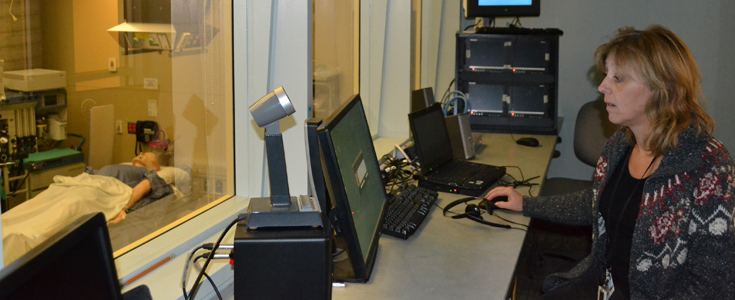Sim lab offers hands on learning
Can you imagine the chance to run through a patient scenario and get hands on experience when even if you mess up, you can still learn without repercussion from the person you're caring for?
While Moose and Reggie might talk, bleed, pee, seize, blink and generally provide verbal and nonverbal feedback on how they're doing, these 3G mannequins in the simulation lab offer those opportunities: to run clinical scenarios without hurting or killing an actual person.
Organizing the simulation lab in the basement of the Brodie Centre at the University of Manitoba's Bannatyne campus is part of Rhonda Usunier's job. A couple of floors upstairs is a wet skills lab. This is where students can practice suturing, IVs and placing central lines along with a multitude of other skills.
Educators and instructors generally take the lead in scheduling time in the simulation lab. Every four weeks code blue sessions are held, and mini wards are held a couple of times a year.
Usunier also supports an interprofessional learning environment and helps run the simulations. Making the learning environment as real as possible has offered interesting opportunities for Usunier, who is a clinical administrator with the university, to learn from other health providers.
Along with stocking three different ICU carts, an emergency cart, difficult airway cart, anesthesia carts and organizing IV and respiratory equipment, she's been working with pharmacy to create options for drugs used in simulations that actually create a real experience, such as foaming when drawn.
"The capability of the mannequins is one thing," says Usunier. "But I'm always asking how can we make it more real?"
The 3G mannequins can be defibrillated, their pupils dilate, they have chest sounds and heart sounds, and you can take their pulse. Their vital signs respond to treatment. When running a scenario, a team of technicians help make the experience as real as possible. One technician has the unique combination of a staging technical background in the world of theatre and health care - so creating wounds and burns to add an element of realism to running a scenario is definitely something she contributes to.
There are three rooms where simulations can be run. Along with Moose and Reggie, there is a birthing mom mannequin that actually gives birth, allowing birthing to be one more scenario that students can run and practice on. There is also a SimBaby and SimJunior mannequin that allow for pediatric and neonatal scenarios.
For each room, behind a two-way mirror is a technical environment where computer programs are set to determine elements of the scenario. Whatever elements are entered into the computer are what prompt Reggie, Moose, the birthing mom or the kids to act or react to the care being offered.
And the scenarios can be videotaped from start to finish, with the goal of debriefing and discussing not only the outcome but elements that created the outcome. Regardless of whether the patient lived or not or the scenario was successful, what can be learned? What could be improved or avoided?
"The sim lab is a safe place to learn. You can make mistakes, learn from those mistakes and won't hurt anybody," says Usunier, noting that an experience in the simulation lab isn't reflective of a person's practice and that like Las Vegas, what happens in the lab stays in the lab. "It can be stressful and intimidating being watched during the simulation and knowing it's being video taped. The video is used in the debrief to learn from and ultimately ask, 'how can we do better in our practices?'"
Usunier stresses the importance of a collaborative learning environment. One element that often comes up when a variety of disciplines get into the classrooms to run a scenario, she observes, is collaborative learning as students discover what their colleagues know and open up to the possibility of learning from each other.
"The goal of running a simulation is for the entire group to find a solution, to solve the problem together. That can often mean learning each other's knowledge base and learning from each other while providing care," she says. "They're all learning together and realize they can rely on each other as they discover what another health care provider knows."
